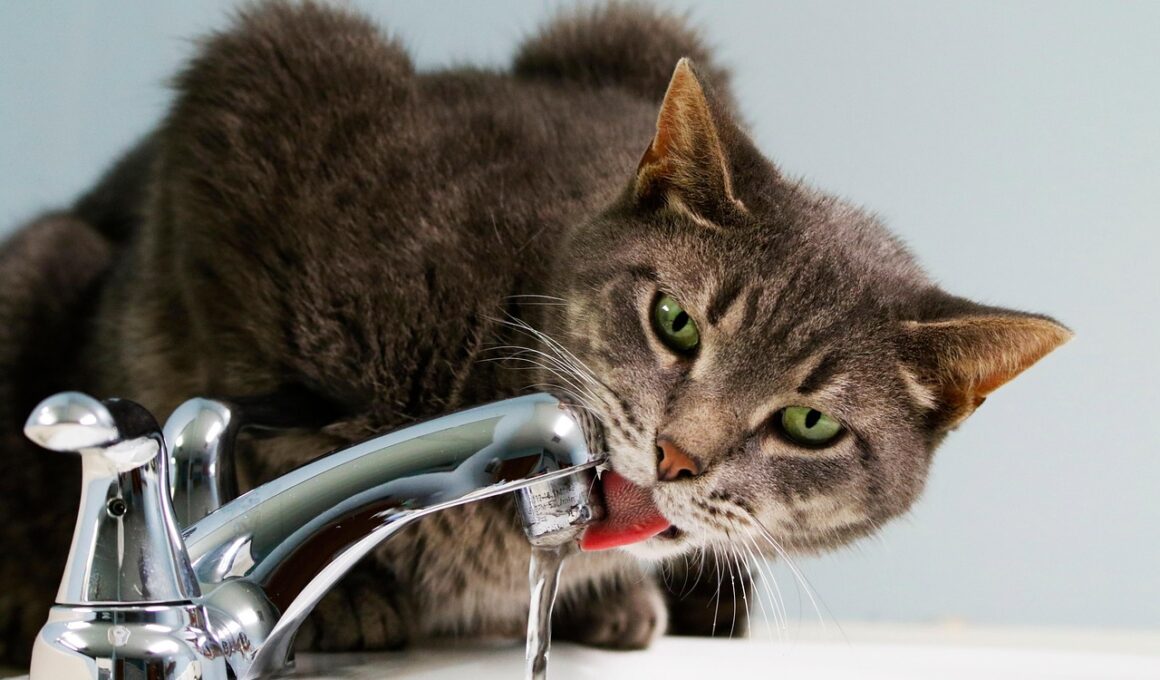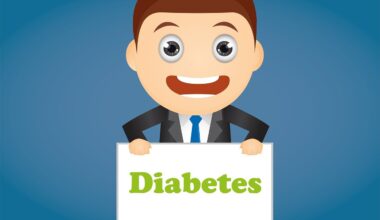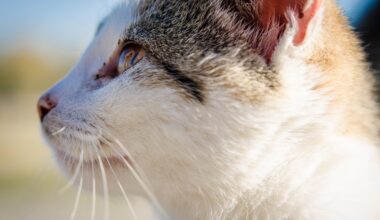Hydration’s Role in Weight Control for Cats
Maintaining optimal hydration levels is crucial in preventing obesity in cats. Just like humans, hydration supports various bodily functions essential for weight management. Water plays a vital role in digestion, nutrient absorption, and metabolic processes; thus, ensuring that your cat is sufficiently hydrated is paramount. Dehydration can lead to a decrease in energy and activity levels, potentially causing weight gain as cats become more sedentary. Providing fresh, clean water is vital to encourage regular drinking habits. Incorporating wet cat food can enhance fluid intake if your cat is reluctant or struggles with drinking water. Always monitor your cat’s drinking habits, as a sudden decrease may indicate underlying health issues. Ensure water bowls are easily accessible and changed daily for freshness. The ideal environment for hydration includes multiple water sources in the house, particularly in areas where they spend significant time. You can also try pet water fountains, as many cats prefer flowing water. Hydration combined with a balanced diet and adequate exercise plays a significant role in keeping your feline friend healthy and fit, thus reducing the chances of obesity.
The Importance of Hydration
Hydration in cats is not merely about drinking water; it involves understanding its whole role in their health and weight. A well-hydrated cat can better regulate metabolism. When cats do not drink enough water, they often rely on dry food and become more vulnerable to dehydration. As a result, metabolism may slow down, potentially leading to unnecessary weight gain. This creates a false cycle where the cat eats more, but without sufficient water intake, they may still struggle to maintain a healthy weight. Moreover, encouraging water consumption supports kidney health, which is particularly important as cats age. As kidneys filter out waste and toxins, hydration can assist in this vital process, thus promoting overall health and wellness. Many pet owners overlook the importance of hydration when it comes to weight control. Understanding your cat’s preferences is key; some may prefer still water, while others thrive on fountains. Experiment to find a method that encourages adequate water consumption. Consider adding a small amount of low-sodium broth to entice your cat while ensuring it’s healthy and suitable for them. Keeping your cat hydrated is an essential step in weight management.
When discussing hydration, it’s essential to recognize the relationship between food intake and water consumption for cats. Cats naturally have lower thirst drives compared to dogs, often getting moisture from their food. If a cat’s diet consists mostly of dry food, they may not be in take enough water, leading to dehydration and weight gain. To counter this, consider feeding a balanced diet that includes both dry and wet food. Wet food contains a higher moisture content and can help maintain hydration levels significantly. Checking the labels on canned food for moisture content aids in exploring more options. Additionally, many cats enjoy treats too, and offering low-calorie, hydrating snacks can be beneficial without adding excessive calories. Try using fruits and veggies that are safe for cats as benefits. Another method involves using pet-friendly ice cubes during warmer months, creating enticing toys that can help increase drinking done naturally. Planning meals around water intake isn’t just a nutritional measure; it forms the basis for a lifestyle change geared towards preventing obesity. Monitor your cat’s weight regularly to ensure their diet aligns with hydration needs.
Signs of Dehydration
Recognizing signs of dehydration in cats is vital to prevent further health issues. As pet owners, keeping an eye on your cat’s hydration status is your responsibility. Some common signs of dehydration include lethargy, dry gums, sunken eyes, and a loss of elasticity in the skin. A simple test is to gently pull the skin on the back of your cat’s neck; if the skin does not return quickly to its original position, this indicates dehydration. You should also observe their drinking habits; a decrease in water intake could signify that your cat is not feeling well or has developed a preference for other hydration sources. Cats who venture outside may drink from natural sources, which might also pose risks. That’s why monitoring their water sources at home is crucial. If you notice any signs of dehydration or any shifts in your cat’s drinking or eating habits, consult a veterinarian promptly. It’s better to err on the side of caution in these matters. Proactive measures can save you from serious health problems, including obesity and urinary tract issues.
Another aspect to consider is the impact of environmental factors on hydration levels. Cats can be sensitive to heat and humidity, which can lead to increased water loss. During the warmer months, their need for hydration intensifies. Ensuring they have ample access to water sources can mitigate risks associated with heat. Indoor air conditioning might dry out the air; thus, sprinkling water daily around the house can create a slightly humid environment that encourages more active drinking. In contrast, during cooler months, ensure that their water does not freeze if you live in colder regions. Also, cats may prefer drinking from bowls that are ceramic or stainless steel as opposed to plastic. Cats can develop a preference for certain textures or materials. Using wide bowls can prevent whisker fatigue and is another way to encourage regular drinking, which assists in weight management and overall health. Additionally, placing bowls in quiet, low-traffic areas can make your cat feel safe while drinking. Remember, optimal hydration enhances your cat’s quality of life and contributes significantly to weight control.
Monitoring Hydration
Administrating appropriate hydration for your cat involves a few practical steps aimed at easy monitoring. Keeping track of how much water your cat consumes each day may seem minute, but it can be terribly insightful. Cats generally drink between 100-200 ml per kg of body weight daily; keeping track of this can reveal inconsistencies or health issues when abnormalities arise. Consider using measuring tools to gauge their water intake accurately. A digital scale can help you determine your cat’s baseline needs and monitor changes; this step can alert you to potential problems before they escalate. Observing changes in drinking habits is crucial. If your cat suddenly drinks drastically more or less, consult your veterinarian. Drinking patterns can reflect underlying medical conditions, particularly in older cats. Tracking water intake frequencies makes it easier to adjust food plans or also introduce more wet food into their diet. Water consumption can surface behavioral issues you didn’t notice before, such as inter-cat competition over bowl access. Solutions often lie in providing multiple bowls or alternative water sources, enhancing the chance of staying adequately hydrated.
The effects of hydration become more noticeable when combined with other preventive measures against obesity in cats. Regular veterinarian check-ups and weight monitoring complement hydration strategies by ensuring a comprehensive health oversight. A holistic approach improves overall wellness and promotes proactive intervention as needed. Balancing hydration with proper diet and exercise leads to remarkable outcomes. Engaging your cats in playtime activities increases their energy expenditure while encouraging regular hydration. Activities can range from purchasing interactive toys to scheduling dedicated playtime with you. Maintaining a relationship where exercise is combined with hydration ensures that your cat remains fit and healthy. It allows excess calories to be burned off, which prevents them from becoming overweight. You can even pair exercise with mealtimes; for example, hiding their food around the house encourages exploration and activity as they hunt for dinner. By implementing a commitment to hydration, coupled with an observant, engaged lifestyle, obesity can often become manageable or indeed avoided altogether. Remember, prevention is always better than a cure.
In summary, hydration is an essential element in preventing obesity in cats. Keeping your feline friends well hydrated promotes overall health and dramatically assists in maintaining a healthy weight. The health benefits are numerous; sufficient hydration aids digestion, improves skin conditions, and can prevent urinary tract issues. Observe your cat’s behaviors related to hydration, adjust diets accordingly, and be proactive about weighing them. Cats thrive when provided with a richer, more interactive lifestyle that encourages healthy engagement and activity. Understanding and monitoring your cat’s hydration needs should be part of a pet owner’s essential responsibilities. Exploring new foods, supplements, and hydration methods can create a more enjoyable experience for both cat and owner, ensuring wellbeing and contentment. Consider consulting your veterinarian regarding optimal hydration methods if you experience difficulty ensuring adequate fluid intake. Tailoring your approach to individual cat needs is where changes can be notable. The weight management process is an ongoing journey that requires attention and care but starts with a focus on quality hydration. By prioritizing this simple yet effective strategy, you can help your cat lead a long, healthy, and fulfilling life.


